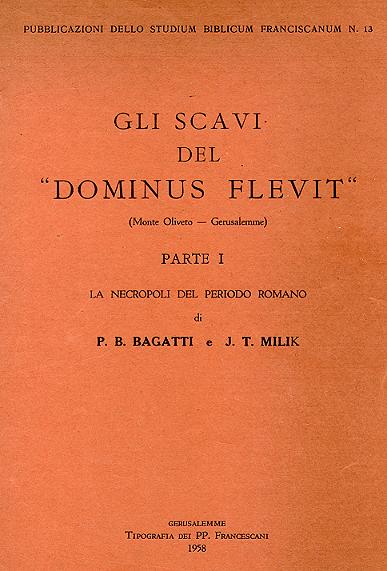
I can't tell you how many times over my years involved in Catholic Apologetics this book has been thrown in my face as "proof" that Peter was never in Rome. Despite reams of historical evidence to the contrary.
Well, recently the University of the Holy Land began investigating this and guess what? It is yet another myth perpetuated by anti-catholics. I thought I would write some on it here, because I can guarantee you that they will not edit their websites in any way. (In other words: Don't bother them with the truth, their minds are made up!)
In a blog titled "Whose son is Simon" members of the universities archaeology team began translating this inscription:

Now, according to Peterson, it reads "Simon bar Jonah" so Peterson concludes that there is only one man in Israel to ever have that name, so it must be Peter of the Bible. Never mind that by the end of his life, no one called him Simon, he is always referred to in Acts as Peter. Also, why would his fellow Christians bury him under his Jewish name and not his Christian one?
The answer of course is that they did not. UHL researchers properly translated the inscription on the ossuary as "Simon bar Zilla". Peterson relied on Bellarmino Bagatti 's translation. But according to the UHL when it came to Bagetti "not a single letter was read correctly".
So, read the article, it is very clear and concise. Once again, the anti-catholics are proved wrong. Which once again leads me to ask:
If they cannot be trusted to tell the truth about Catholicism, why should I trust them to tell the truth about Jesus?





6 comments:
There are some amongst us who are intelligent enough to be able to read the bible and draw the necessary conclusions that tell us that Peter was never in Rome after the death of Christ, period. These silly arguements between roman catholics and anti roman catholics about various unverifiable archaeological artifacts and bones is just the usual religious frenzied grappling at anything that satisfies peoples blind faith. I know where my money is and thats on Gods Holy Book, but I guess there are those who will twist that too in order to satisfy their infused religious beliefs.
Interesting that "Mr. Anonymous," who claims to be among the intelligent, gives no proof whatsoever for his absolutist assertion that "Peter was never in Rome." Where in the Bible does it say he was NOT in Rome? Nowhere. Some claim this is implied because Paul never mentions Peter in Rome. But this is mere speculation, as abscence of proof is not proof of abscence. Peter, on the other hand, does indirectly state he was in Rome. He ends his first epistle "from Babylon," which was early Christian code for Rome (see Revelations) -or did you really think Peter went to Babylon, which at the time was but a pile of rubble?
So even if we were to disregard the mountains of archaelogical evidence, or the writings of multiple early Christians, and were to solely rely on the Bible, there IS evidence that Peter was in Rome, much to the chagrin of some Protestants...
Christian said that their proof that Peter was in Rome is 1 Peter 5:13 states that peter greets his readers from Babylon!
But the Here is the real Babylon in Iraq and not in Rome!
Because Babylon was still inhabited until 600 Century AD. Read this book....... Late Achaemenid and Hellenistic" on Page 192 at the end of that page says that Theodoretus testifies that Jews still live in Babylon until his lifetime during 6th century AD!!!!
THIS ONLY PROVES THAT THE BABYLON OF 1 PETER 5:13 IS NOT ROME BUT THE LITERAL BABYLON ITSELF! BECAUSE BABYLON IS STILL INHABITED BY JEWS UNTIL 6TH CENTURY AD.
Christian said that their only proof that Peter was in Rome is 1 Peter 5:13 which states "She who is in Babylon, chosen together with you, sends you her greetings, and so does my son Mark."
But the real Babylon is in Iraq and not in Rome!
Because Babylon was still inhabited until 600 Century AD. Read this book....... Late Achaemenid and Hellenistic" on Page 192 at the end of that page says that Theodoretus testifies that Jews still live in Babylon until his lifetime during 5th century AD!!!!
THIS ONLY PROVES THAT THE BABYLON OF 1 PETER 5:13 IS NOT ROME BUT THE LITERAL BABYLON ITSELF! BECAUSE BABYLON IS STILL INHABITED BY JEWS UNTIL 5TH CENTURY AD.
READ THIS BOOK "LATE ACHAEMID AND HELLENISTIC BABYLON".... page 192
from this link.....
http://books.google.com.ph/books?id=1frplXFGf4sC&pg=PA192&lpg=PA192&dq=lifetime+(fifth+century+AD)+Jews+still+lived+in+Babylon&source=bl&ots=Tmzk1J6mBx&sig=MRSKZ2s7cft5EPozO87wz56gX1w&hl=fil&sa=X&ei=K9tIUvjiNayUiAe33YDQAg&ved=0CCgQ6AEwAA#v=onepage&q=lifetime%20(fifth%20century%20AD)%20Jews%20still%20lived%20in%20Babylon&f=false
I am not the same "Anonymous" that previously commented. I think that the arguments from the Protestants on this thread are based on propaganda rather than facts.
Regarding the word "Babylon" in 1 Peter 5:13
It has been suggested that this passage proves Peter was in Rome because Babylon is believed to represent ancient Rome in the book of Revelation. According to the book of Revelation, Babylon rests on 7 hills/mountains. There are many cities that supposedly rest on 7 seven hills/mountains: Moscow, Washington DC, Tokyo, Ammon, Istanbul, Prague, Melbourne, San Francisco, Rio De Janeiro, Rome, Jerusalem, etc. Of these cities, the most relevant would be Rome or Jerusalem.
The Babylon of 1 Peter 5:13 could be:
#1 A metaphor for Rome.
#2 A metaphor for Jerusalem
#3 A place in Heliopolis, Egypt where the deity "Hapi" supposedly resided.
#4 A fortress located in Old Cairo, Egypt
#5 The original city of Babylon in ancient Mesopotamia (it was in ruins when Peter wrote his letters).
#6 The city of Seleucia on the Tigris (aka new Babylon)
There would be no logical reason for Peter to use a metaphorical term for Jerusalem. There also would be no logical reason for Peter to write his letter from Heliopolis, Old Cairo, or from a desolate area where ancient Babylon used to be. That leaves two possibilities: The city of Seleucia on the Tigris, or Rome.
Seleucia was located in Mesopotamia. According to Josephus, many Jews lived there during the first century B.C. (when Hyrcanus was alive). [For more information, see Antiquities 15:2:2] Seleucia would have been existing during the time of Peter (the Romans destroyed it many years later in 165 A.D.). Seleucia was called "Babylon" because it became a leading city in Mesopotamia just like the original city of Babylon.
At the time when Peter wrote his letters, Nero was emperor. Many Christians suffered persecution under Nero. Why is that important? Because it explains why Peter might have substituted the word "Rome" with a metaphorical term (Babylon). As a Christian, he may have been cautious about disclosing his location if he did not want to be discovered by the Roman authorities.
There is no biblical evidence to substantiate that Peter was in Seleucia or in Rome when he wrote his letters. However, there also is no biblical evidence to substantiante that he was not in those cities when his letters were written.
I believe Peter was never in Rome. He is just too old to be there and for what. The only thing that Roman Catholicism wanted Him is because of that KEY (I don't know what it represents or is it a tangible key was given to Him by Christ) so therefore he succeeds Christ. The church wanted the sole authority --- i don't know - it is about faith? What authority is there by the way - to be God - to forgive sins? The Roman Catholic Church wanted its believers to think that the church's foundation is St. Peter as he buried in Rome. Then the church claimed him to the first Pope. Its just ridiculous. Peter was never a Pope. He is dead by a thousand years before the papacy began. I don't know why..for me the rightful person to be the foundation of Catholicism should have been St. Paul -- because even the apologist would claim that St. Peter is for the Jews and Paul to the Gentiles. Those ossuaries found in Jerusalem is more reliable that the volumes of encyclopaedia published just to proved that the bones of St. Peter is found buried in Rome.
Post a Comment